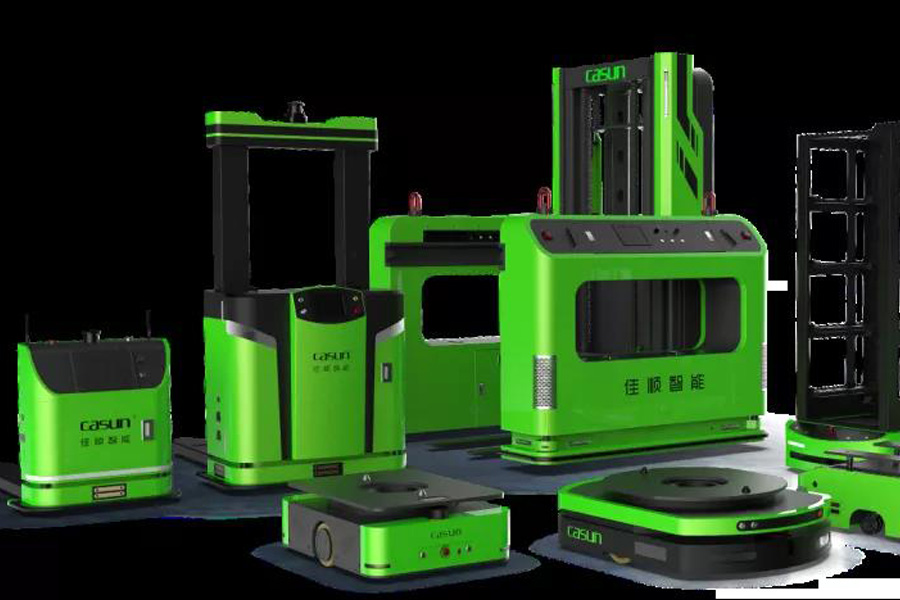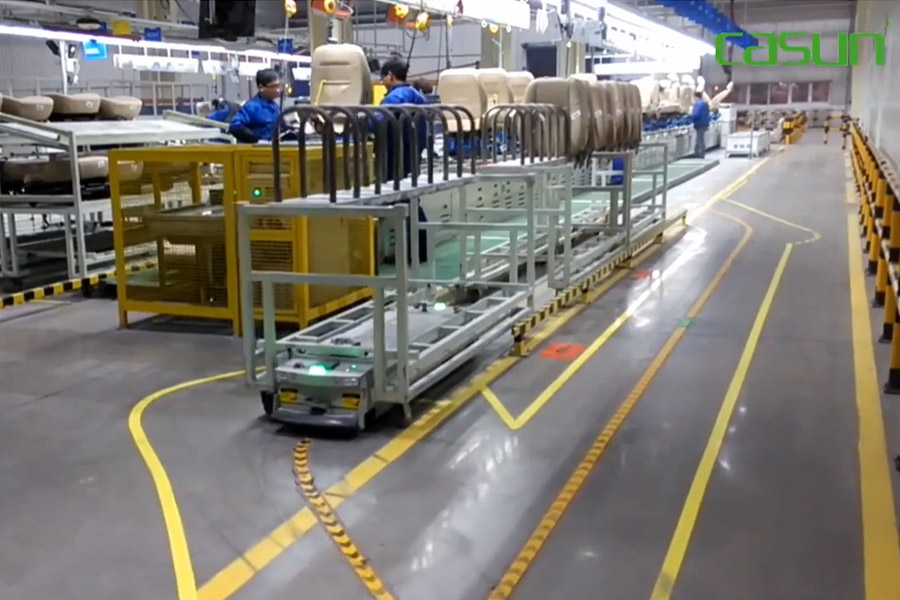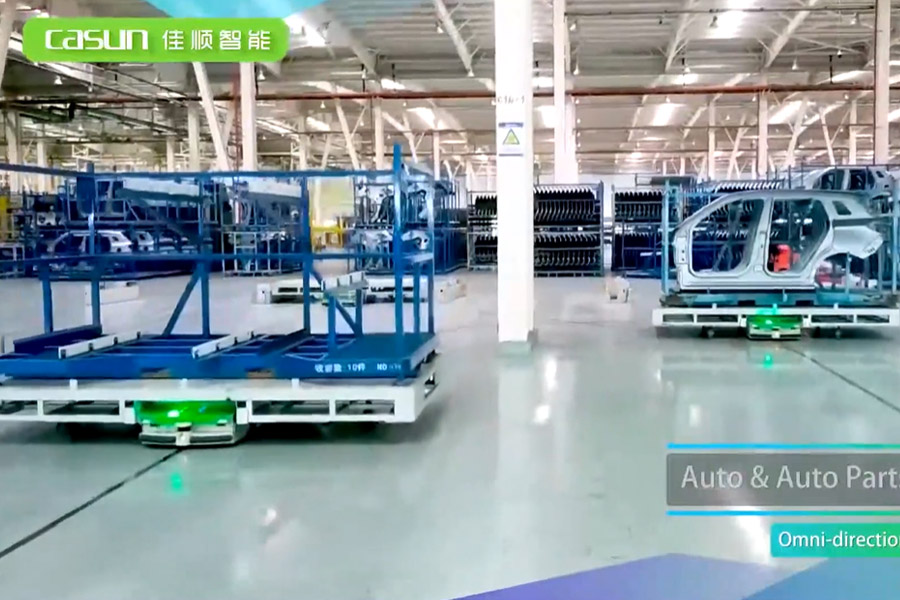With the advent of the new industrial era, smart factories, unmanned workshops, and manufacturing enterprises have an increasing demand for intelligent logistics handling. Enterprises can realize unmanned and intelligent handling by using mobile robots (AGV). Compared with traditional manual handling, companies can significantly improve the overall operating efficiency of the factory.
AGV is an unmanned transport vehicle, that is, an “automatic guided transport vehicle”, which is widely used in the transfer of materials or finished products between production lines and warehouses. It also has a cross-floor transfer function to meet the needs of multi-floor and multi-region material transportation. The AGV cross-floor handling technology independently developed by CASUN can enable the AGV to interact with the elevator or electronic door signal, and automatically complete the AGV access elevator, electronic door, and other floor conversion and regional transfer actions, effectively solving the cross-floor, Difficulties in multi-zone material handling.

Contents
CASUN AGV and elevator docking application case
In order to reduce the number of elevator round trips, improve the efficiency of elevator transportation, and meet the needs of fast-paced operation scenarios, CASUN has developed a set of elevators that can enter and exit two or more AGVs at the same time. It has been promoted and applied in multiple industries. , Reaching the leading level in the industry.
AGV and elevator docking
Achieve technical requirements for cross-floor handling
- Hardware requirements for AGV and elevator docking
- The elevator control box is equipped with a wireless docking system provided by CASUN.
- The signal interaction between the wireless docking system and the elevator controller is implemented in accordance with the communication protocol (CASUN has developed AGV and elevator communication standard protocols with many well-known elevator brand manufacturers).
- When the AGV interacts with the elevator signal, the wireless docking system will send the wireless signal sent by the AGV to the elevator controller. At the same time, the wireless docking system will collect the floor signal of the elevator controller and the elevator status signal, and then send the wireless signal to the AGV to realize the AGV Signal interaction with elevators.
- When the AGV is docked with the elevator, the signals sent by the AGV are: each floor signal of the elevator, door opening signal, and door closing signal; the wireless docking system collects signals from the elevator controller: each floor signal of the elevator, leveling signal, and door opening is completed Complete signal with closing door.
AGV and elevator docking process
No. | AGV action signal | Process and function description | Elevator action signal |
1 | AGV runs to the elevator entrance | ||
2 | AGV sends up/downstairs signal | AGV sends a request to the elevator to enter the elevator signal | |
3 | The elevator receives the signal of going up/down, and judges whether there is AGVs in the elevator, and the elevator without AGVs runs to the designated floor | Elevator sends signal to 1/2 floor | |
4 | The elevator arrives at the designated floor, and after the door is opened, the signal is sent to the AGV | The elevator sends the door open signal | |
5 | Send door closing signal | AGV arrives at the stop point in the elevator, and outputs an in-position signal to the elevator to notify the elevator to close the door | |
6 | The elevator detects that the AGV is in place, and then the elevator closes the door | ||
7 | After the elevator door is closed in place, the AGV will be automatically sent to the designated floor | ||
8 | The elevator sends the AGV to the designated floor and then opens the door. When the door is fully opened, the AGV is notified to let it go | Send floor signal and floor door open signal | |
9 | Send door closing signal | After the AGV receives the floor signal and the door open in place signal, it will let it go, and after it has completely exited the elevator, it will notify the elevator to close the door |
Technical difficulties of AGV cross-floor transportation
- When the AGV and elevator docking technology is not perfect, companies seldom consider the introduction of AGV cross-floor handling projects. Usually choose to use AGV to pull the material car to the elevator entrance, and the personnel and the material car will enter the elevator together. After reaching the designated floor, the personnel will then pull the material car to the endpoint. Use this method to cooperate with AGV to transport materials. This is not only a waste of manpower but also because the door opening and closing time are uncontrollable during the process of entering and exiting the elevator, it is prone to safety accidents such as pinching and crashing.
- After the AGV and elevator docking technology is mature, companies are more concerned with the stability and safety of the AGV docking with the elevator, such as signal loss or signal transmission and reception errors, etc., which causes the AGV to not work properly when docking with the elevator. Through technical research, CASUN successfully solved the industry’s pain points such as signal drop, signal loss, and signal misoperation that occurred with a small probability when the AGV was docked with the elevator. And develop a communication protocol between AGV and elevator with elevator manufacturers to realize closed-loop control and ensure that the communication is 100% normal.
- Under the premise of stable and reliable docking between AGV and elevator, the customer proposed that elevator operation efficiency should be improved to reduce unnecessary waiting. In this regard, AGV manufacturers need to solve the difficulty of two or more AGVs entering and exiting the elevator at the same time. In addition, when the frequency of elevator usage increases, multiple AGVs will wait in line at the elevator entrance. In response to the above needs, CASUN dispatches and controls AGVs through the upper computer system, and combines the independent communication technology between AGVs to successfully solve the above problems. Realize the reasonable and orderly entry and exit of multiple AGVs, avoiding congestion at the elevator entrance, and making the logistics and transportation proceed smoothly and orderly.
AGVS system and MES/WMS system docking
From warehouse to the workshop, and then from workshop to warehouse, cross-floor handling does not fully reflect the operational advantages of AGV. Through the docking and integration of the AGVS system and the MES or WMS system, the AGVS system can efficiently, accurately, and flexibly complete the logistics handling tasks with the help of system information management platforms such as MES/WMS, which improves the flexibility of production and the competitiveness of the enterprise.


